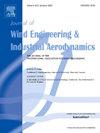Identification of flow regimes and dispersion pathways around in-line cylinders
IF 4.2
2区 工程技术
Q1 ENGINEERING, CIVIL
Journal of Wind Engineering and Industrial Aerodynamics
Pub Date : 2025-02-23
DOI:10.1016/j.jweia.2025.106046
引用次数: 0
Abstract
Flow and dispersion over in-line cylinders have received considerably less attention compared to those around isolated cylindrical obstacles in the fluid dynamics literature and within cuboid-delimited street canyons in the urban boundary-layer context. This investigation reveals that tank canyons share similar flow characteristics with street canyons while demonstrating distinct features. The flow regime transition from isolated to wake interference and skimming with respect to the canyon aspect ratio (), well established for urban canyons, is preserved in the case of tank canyons; however, turbulent flux exchanges across the canyon side open boundaries are more pronounced in the latter, attributed to reinforced flow encirclement around the cylindrical obstacles and enhanced horseshoe vortices. Dispersion pathways, in particular the centre-of-mass translation and mean tracer ages (), closely align with the flow regime. The overall monotonic increase in with , alongside a notable () decrease in the mean canyon circulation timescale (), offers useful insights for the parameterisation of key timescales associated with flow and ventilation in cylinder-delimited canyons. Knowledge of the microenvironments within tank canyons is vital for integrating complex petrochemical plants into urban topographies, constituting an integral part of urban micrometeorological systems.
直列圆柱周围流动形式和分散路径的识别
与流体动力学文献中孤立圆柱形障碍物周围的流动和分散以及城市边界层中长方体划定的街道峡谷内的流动和分散相比,在线圆柱体上的流动和分散受到的关注要少得多。研究表明,槽谷与街谷具有相似的流动特征,但又表现出不同的特征。关于峡谷宽高比(AR),在城市峡谷中建立的从孤立到尾流干涉和掠流的流型转变在坦克峡谷中得到了保留;而在后者中,峡谷两侧开放边界的湍流通量交换更为明显,这是由于围绕圆柱形障碍物的流动包围增强和马蹄涡增强所致。色散路径,特别是质心平移和平均示踪剂年龄(τa),与流动状态密切相关。τa随AR的整体单调增加,以及平均峡谷环流时间尺度(Tc)的显著(~ 30%)减少,为柱面峡谷中与流动和通风相关的关键时间尺度的参数化提供了有用的见解。了解罐谷内的微环境对于将复杂的石化工厂整合到城市地形中至关重要,这是城市微气象系统的一个组成部分。
本文章由计算机程序翻译,如有差异,请以英文原文为准。
求助全文
约1分钟内获得全文
求助全文
来源期刊
CiteScore
8.90
自引率
22.90%
发文量
306
审稿时长
4.4 months
期刊介绍:
The objective of the journal is to provide a means for the publication and interchange of information, on an international basis, on all those aspects of wind engineering that are included in the activities of the International Association for Wind Engineering http://www.iawe.org/. These are: social and economic impact of wind effects; wind characteristics and structure, local wind environments, wind loads and structural response, diffusion, pollutant dispersion and matter transport, wind effects on building heat loss and ventilation, wind effects on transport systems, aerodynamic aspects of wind energy generation, and codification of wind effects.
Papers on these subjects describing full-scale measurements, wind-tunnel simulation studies, computational or theoretical methods are published, as well as papers dealing with the development of techniques and apparatus for wind engineering experiments.

 求助内容:
求助内容: 应助结果提醒方式:
应助结果提醒方式:


